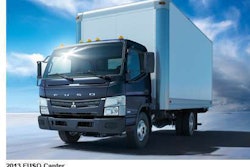While vehicle OEMs traditionally have focused on their core competency of vehicle usage and vehicle analysis, this has placed them at a disadvantage to independent aftermarket telematics vendors, whose core competence is in transport operation, according to Frost & Sullivan. OEMs typically have limited client contact after selling the vehicle, but this is expected to change once OEMs gradually start offering fleet management systems as a standard in their models.
A new analysis from Frost & Sullivan, “Strategic Update of European Medium and Heavy-duty Commercial Vehicle Telematics Market,” finds that the market registered sales of 542 million in 2010 and estimates this to reach 1.3 billion in 2017. Frost & Sullivan anticipates almost half the vehicles produced to have a FMS as a standard line-fit by 2017. Telematics solutions supporting an open and flexible platform will allow vehicle manufacturers to survive long-term in this competitive market.
“The current trend of offering FMS as a standard in line-fit has slowly started, with each OEM having mapped out its own strategy based on its business needs,” says Sathyanarayana Kabirdas, Frost & Sullivan industry analyst. “Such an approach is poised to increase OEMs’ year-on-year FMS installed base in the coming year and neutralize competition.”
Some OEMs might consider offering FMS as a standard based on the country in which they are being offered, while others might base it on models, changing platforms, miles driven or pricing. At present, however, most OEMs consider the particular market or country when offering FMS as standard.
“Certain models sold in Benelux, France or Germany, for example, have FMS as a standard, while the same models sold in Italy or Ukraine do not have FMS as standard simply because of the varying level of demand and awareness,” says Sathyanarayana.
A key issue for OEMs is that hardware penetration might not necessarily equate to service penetration because some operators do not want to be linked to OEMs or to a particular OEM, according to Frost & Sullivan. At the same time, some OEMs do not have the capability of expanding outside their own vehicle line. Moreover, operators with mixed fleets do not favor OEMs’ base telematics system. Thus, even with the hardware in place, OEMs are unlikely to win all the associated service opportunities.
“Even if OEMs start to offer FMS as a standard, there is always a difference between hardware being in place and the service being activated – these two things are very different,” says Sathyanarayana. “The presence of the hardware in the truck does not necessarily mean that it is going to be used by the fleet operator.”
This strategy of offering a standard quality fitment, suiting all types of customers and extending the continued relationship is expected to have a positive influence on the market presence of OEMs in the coming years, Frost & Sullivan says. This strategy not only will help OEMs to increase their base of active subscribers but also will help them collect a large pool of real-time vehicle-specific data to build better trucks for the future.
“The best way to increase the base of active subscribers is by offering an initial free subscription period of at least a few months or years,” says Sathyanarayana. “This will allow the truck owners to realize the benefits of FMS.”












